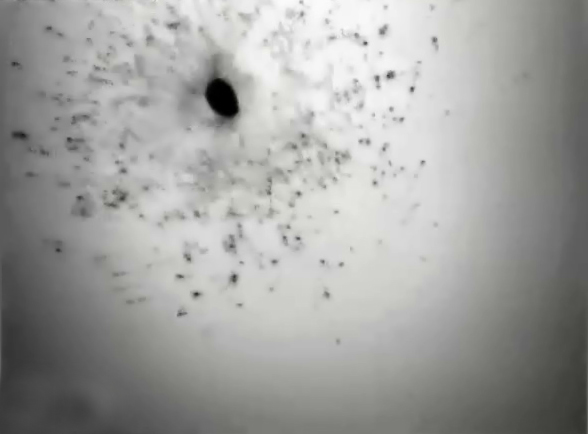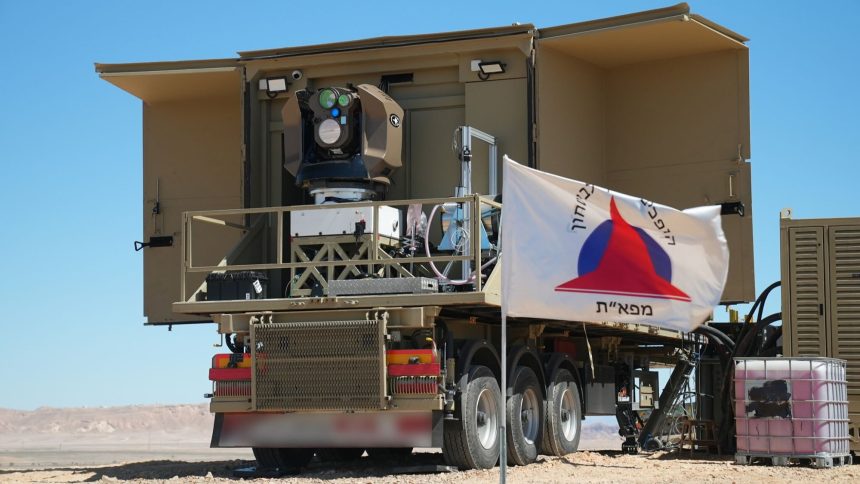Israeli officials describe the Iron Beam system as being designed to work in tandem with existing air defense platforms such as Iron Dome, Arrow, and David’s Sling.
Israel’s Defense Ministry on Oct. 28, 2024 declared that its under-development laser-based DEW (Directed Energy Weapon) Iron Beam would be operational within a year. The Ministry’s director general Eyal Zamir announced signing a contract with defense firms Elbit and Rafael to that effect. “The first capability of the ground laser system…is expected to enter operational service in a year from today,” The Times of Israel (ToI) quoted Zamir.
Israeli officials describe the system designed to work in tandem with other existing air defense platforms like the Iron Dome, and possibly Arrow, David’s Sling and the U.S.’s THAAD (Terminal High Altitude Air Defense) that was recently deployed there. This appears to be a classic Integrated Air Defense system that coordinates and networks with SAMs of progressively overlapping ranges, in a multi-layered protective ‘umbrella’.
The Iron Beam is a 100kW-class High-Energy Laser Weapon System by Rafael Advanced Defense System, first publicly unveiled at the 2022 iteration of AUSA symposium in October of that year. A video by the company said it is highly effective against rockets, mortars and drones. A thermal-mode footage from a test in Mar. 2022 showed it disabling a drone, where the UAV’s wing broke off and it hurtled to the ground. Other targets included a mortar and a rocket.
Israel’s in development high-powered laser interception system, dubbed Iron Beam, is expected to be operational within a year, the director general of the Defense Ministry says.
“The first capability of the ground laser system… is expected to enter operational service in a… pic.twitter.com/M427tsHuoV
— Emanuel (Mannie) Fabian (@manniefabian) October 28, 2024
‘Economical, supplement other air defense systems’
The ToI said that the agreement between the ministry, Rafael and Elbit will “significantly increase” the rate of production “in order to supply the laser systems on time and at a high rate.” An earlier ToI report from April 2022 that talked about the above mentioned tests, quoted Brig. Gen. Yaniv Rotem saying the trials were conducted at “challenging” ranges and timings.
“The use of a laser is a ‘game changer’ and the technology is simple to operate and proves to be economically viable,” he said. The tests were conducted in southern Israel’s Negev desert. Israel has been testing the laser-based defense system for several years.
ToI added that the system’s development was driven by “concerns” in a future conflict where the military might “not have sufficient interceptor missiles for the Iron Dome and other air defense systems to shoot down incoming rockets, missiles, and drones.” “Every effort is being made to make the system operational as soon as possible and enable an efficient, inexpensive, and innovative protection umbrella,” it quoted then Defense Minister Benny Gantz.

Iron Beam “is not meant to replace the Iron Dome or Israel’s other air defense systems,” but rather “supplement and complement” them, shooting down smaller projectiles and leaving larger ones for the more “robust missile batteries.”
Military-strategic overview of Iranian and Israeli capabilities
The development comes close on the heels of direct military confrontation with Iran and intermittent clashes with the Houthis where large volumes of ballistic missiles, drones and cruise missiles often overwhelm Israeli air defenses. Indeed, reports of the existing Iron Domes “failure” are not entirely reliable since the system is programmed to prioritize and engage only those projectiles that are heading towards critical targets, while ignoring the others.
Moreover, Israel also learnt from Iran previous missile barrage that was in retaliation to the Israeli Air Force’s strike on the Iranian embassy in Syria. Analysts noted it may have been intended to provoke Israel’s air defenses and give Tehran significant insight into its anti-air deployment and reaction times. The latest strike over the Nevatim air base saw very little Israeli anti-air fires, suggesting Tel Aviv swiftly incorporated the lesson and chose to ignore the Iranian ballistic warheads. The missiles caused little damage, hitting only hangars and buildings, as seen in subsequent satellite imagery.
Nevatim Air Base has 3 hits from Iranian Ballistic Missiles.
1. Hit a taxiway.
1. Hit next to the hanger
1. Hit the hanger.
Unknown if any aircraft stored inside at the time of the attack. https://t.co/94P3tpxsQ0 pic.twitter.com/CyLZmMuZbZ
— Intelschizo (@Schizointel) October 3, 2024
But an argument can be made that both Iran’s latest missile rain and Israel’s retaliatory strikes at Tehran’s military factories had more strategic and political messaging intent. They were demonstrative in nature, exhibiting their respective capabilities. Both countries have credible and lethal capabilities, making the other mutually vulnerable.
Israel possesses conventional high-end technology with fourth and fifth generation jet-armed air force that can strike Iran’s bigger military bases and nuclear facilities. Iran meanwhile has greater strategic depth owing to a large landmass and a bigger and distributed defense industry. Learning from close ally Russia, Tehran has designed its defense industrial base in a way where it can swiftly revive and keep producing both strategic missiles and tactical systems, suited for ‘long wars’ and overturn initial military setbacks.
Conclusion
The Iron Beam’s small size and mobility makes it difficult to track and unburden larger air defense missiles of incoming projectiles, freeing them up to prosecute other larger swarms of missiles. DEWs are particularly suitable for missiles in their descent and terminal stages, where MaRVs (Maneuvering Reentry Vehicles) used in Iranian ballistic missiles, make them nearly impossible to be engaged by short and medium-range SAMs.
The destruction is also achieved at significantly less costs than exorbitant kinetic weapons. Moreover, lasers also do not have to fully destroy or ‘fry’ a missile, since a powerful beam adequately disables its electronics, guidance and navigation systems, causing it to miss and veer off-course. Israel’s ability to mass manufacture and field the Iron Beam swiftly, after extensive testing in exercises, will decide the extent to which it can be impervious to Iranian, Houthi and Hezbollah missiles.
A perennial technical challenge with laser-based DEWs remains the susceptibility to poor weather like fog, cloud cover and mist, that degrades the beam’s strength. But then it would be as much a challenge for attacking Iranian missile seekers and drones too, impacting their optical and radar sensors. Both rely and photographic and radar image correlation and matching techniques to identify targets and begin their attack runs.









